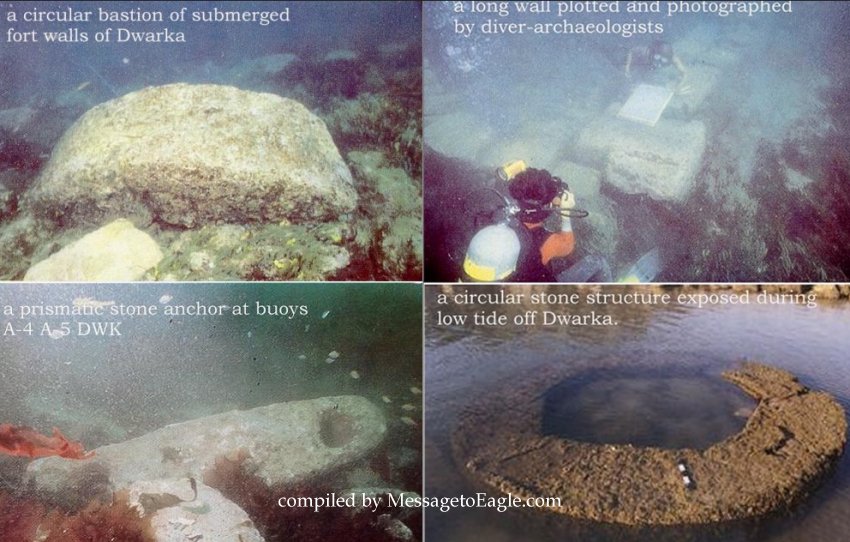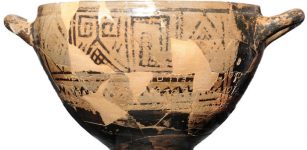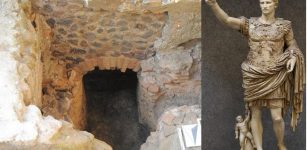Sophisticated Vimanas Over Dwarka – Pre-Harappan City That Could Rewrite The History Of The World
MessageToEagle.com – Could Dwarka be the oldest civilization in human history?
Krishna’s legendary Dwarka built on the site of an even earlier sacred city, named Kususthali, was a well-planned city with a modern and technologically advanced harbor adjusted to traffic of large entering ships. An advanced society lived there.
Dwarka – a long-lost mythical city, one of the seven holy cities in Hindu India, is a reality.
The city of Dwarka has been investigated by historians since the beginning of the 20th century. Also the exact location of this port city has also been debated for a long time. Several references from the Mahabharata, the Bhagvata Purana and the Vishnu Purana have been used to suggest the city’s exact location.
The remains of what has been described as a huge lost city, found by researchers not long ago, may force historians and archaeologists to radically reconsider their view of ancient human history.
Krishna’s kingdom spread across’ northern India and Pakistan, with its capital in ancient Dwarka, on the coast in Gujarat, just near the Pakistan border.
However, as a god of war, Krishna had a lot of enemies. His beautiful Dwarka was constantly in danger to be defeated because it was a battlefield for lord Krishna and King Salva, a king of this earth, who developed an intense animosity toward Lord Krishna and strongly vowed to destroy Krishna’s city of Dwarka, the sacred text of the Bhagavata Purana says.
A number of sophisticated military activities tortured the beautiful city.
In aerial battles, the gods used a variety of weapons and amazing flying vehicles. One passage in the Sanskrit texts describes a special air battle between the hero Krishna and the dangerous Asura leader, King Salva. King Salva had a flying machine called “Saubha-pura” which he used when he launched an attack against Krishna’s capital Dwarka.

The Mahabharata describes King Salva’s attack on Dwarka with a flying machine. It is the description of the battle that was fought with sophisticated technology and advanced weapons, potentially even with a craft attacking from the orbit. The spacecraft commenced an attack on the city with the use of energy weapons, which to the on-lookers resembled a discharge of a lightning, and it was so devastating that after the attack most of the city lay in ruins.
Salva’s incredible and powerful flying machine – equipped with high-tech weapons and described as an “iron city” – was extraordinary; it could hover in the air, float on water, become invisible to the enemy.
With his Saubha-pura, king Salva was able to terrorize and kill many of the Vrishnis, a tribe whose warriors include the great Krishna.

“The cruel Salva had come mounted on the Saubha chariot that can go anywhere, and from it he killed many valiant Vrishni youths and evilly devastated all the city parks,” we read in Mahabharata.
Krishna’s warriors had no intention of giving up the battle, and continued their fighting and the hero Pradyumna wanted to release what appears to be one of the most dangerous weapons against king Salva, but the highest gods stopped him explaining that: “Not a man in battle is safe from this arrow.”
Instead, it was decided that Salva will fall to Krishna and a remarkable aerial battle began again. Krishna’s flying machine chased the Asura king in his very fast flying Saubha-pura, but Salva responded firing his weapons.
According to Krishna’s, own relation in the Mahabharata:
“His Saubha clung to the sky at a league’s length… He threw at me rockets, missiles, spears, spikes, battle-axes, three-bladed javelins, flame-throwers, without pausing. The sky… seemed to hold a hundred suns, a hundred moons… and a hundred myriad stars. Neither day or night could be made out, or the points of compass.”
Krishna returned the fire.
“I warded them off as they loomed toward me. With my swift-striking shafts, as they flashed trough the sky. And I cut them into two or three pieces with mine. There was a great din in the sky above.”
Around 1500 BC the whole western coast of India mysteriously disappeared along with Dwarka – the great city of gold. The deluge came and the submergence took place immediately after Sri Krishna departed from the world.
This catastrophic event is confirmed by the sacred texts of the Vishnu Purana stating that “on the same day that Krishna departed from the earth the powerful dark-bodied Kali Age descended. The ocean rose and submerged the whole of Dwarka.”
The Age of Kali thus ushered in turns out to be none other than the present epoch of the earth – our own. According to the Hindu sages it began just over 5000 years ago at a date in the Indian calendar corresponding to 3102 BC.

It is an age, warns the Bhagvata Purana, in which people will be greedy, take to wicked behavior, will be merciless, indulge in hostilities without any cause, unfortunate, extremely covetous for wealth and wordly desires,” Hancock writes in his book “Underworld”)
Also in the Mahabharata, there is a specific account given by Krishna’s main disciple Arjuna about the submerging of Dwaraka, by the sea which reads as follows:
“The sea, which has been beating against the shores, suddenly broke the boundary that was imposed on it by nature. It rushed into the city, coursing through the beautiful city streets, and covered up everything in the city. I saw the beautiful buildings becoming submerged on by one. In a matter of a few moments, it was all over. The sea had now become as placid as a lake. There was no trace of the city. Dwaraka was just a name; just a memory…” –
For more than 5,000 years Dwaraka was treated only like a myth, handed over from one generation to another.
The following story entitled “Harappan-like Ruins Discovered In Gulf of Cambay” made headline news in the Indian press in 2001:
In a major marine archaeological discovery, the Indian scientists have come up with excellent geometric objects below the sea-bed in the western coast, similar to the Harappan ruins,” reported The Hindu
“This is the first time that such sites have been reported in the Gulf of Cambay,” the Science and Technology Minister, Dr. Murli Manohar Joshi, told reporters today.
The discovery was made … when the multi- disciplinary underwater surveys, carried out by the National Institute of Ocean Technology (NIOT), picked up images of several “excellent geometrical objects” which were normally man-made in the nine-kilometre-long stretch, west of Hazira in Gujarat.
“It is important to note that the underwater marine structures discovered in the Gulf of Cambay have similarity with the structures found on-land on the archaeological sites of Harappan and pre-Harappan times,” Dr. Joshi said.

The acoustic images showed the area lined with well-laid house basements like features partially covered by sand waves and sand ripples at 30-40 metre water depth. At many places, channel-like features were also seen indicating the possible existence of possible drainage in the area, he said.”
The vast city – which is five miles long and two miles wide – is believed to predate the oldest known remains in the subcontinent by more than 5,000 years. Mainstream scientists maintain that ancient Indian culture/civilization goes back some 4-5 thousand years. Yet the ruins below the Gulf of Cambay go back at least 9 thousand years, i.e. to the time when the area submerged under water.
This means that the city must have existed before the flooding, i.e. at least 9 thousand years ago.
The Gulf of Cambay waters revealed sandstone walls, a grid of streets and some evidence of a sea port 70 feet under water.
About 2,000 artifacts were found 40 meters under the ocean. The artifacts were spread over an area of 9 kilometers. There were remains of rectangular buildings, bathing facility, chiseled stone tools, broken pieces of potteries, jewelry, and the human jaws and teeth.
Identical pottery has been found in the submerged city of Dwarka. Thus the results have proved that the account in Mahabharata as to the existence of a beautiful capital city of Dwarka of Sri Krishna was not a mere figment of imagination but it did exist, according to another scholar Nanditha Krishnan.
The ruins have been proclaimed the remains of Krishna’s lost city of Dwarka.
Excavations conducted at the city by Dr S.R. Rao (1922 – 2013) an Indian archeologist who led teams credited with the discovery of a number of Harappan sites including the famous port city of Lothal in Gujarat and founder of the Marine Archaeology Center of the National Institute of Oceanography of India (NIO) have finally revealed that the descriptions as found in these sacred texts are not to be discarded as fanciful.
It has greatly narrowed the gap in Indian history by establishing the continuity of the Indian civilization from the Vedic Age to the present day, according to Dr. S R Rao.
There is a certain pilgrim city called Dwarka, a place of commemoration of the lost antediluvian city of Krishna and it is a destination for all Krishna worshippers.
In the city, there is a magnificent Dwarkadish temple, sacred to Lord Krishna. During excavation works, archaeologists detected many layers of earlier constructions beneath and around the temple. Apparently, the temple had been built on something even older. In addition, underwater ruins have also been found between 3-10 meters from the shore, where the today’s Dwarka is located.
The discovery of Dwarka – an important historical landmark of India – has set to rest the doubts expressed by historians about the historicity of Mahabharata and the very existence of Dwarka city.
The antediluvian Dwarka was not a fable, but a city that really existed and this fact may soon force us to re-evaluate and rewrite not only the history of the Indian subcontinent and the whole world.
Copyright © MessageToEagle.com. All rights reserved. This material may not be published, broadcast, rewritten or redistributed in whole or part without the express written permission of MessageToEagle.com
Related Posts
-
 Mystery Of The Kappas That Moved Swiftly Over The Waters Or Across The Sky
No Comments | Jun 16, 2014
Mystery Of The Kappas That Moved Swiftly Over The Waters Or Across The Sky
No Comments | Jun 16, 2014 -
 Mystery Of Sacred Groves Of Oshogbo And Its Remarkable Ancient Figures
No Comments | Jan 15, 2024
Mystery Of Sacred Groves Of Oshogbo And Its Remarkable Ancient Figures
No Comments | Jan 15, 2024 -
 Mystery Of The Tomb Of Nestor’s Cup Unraveled
No Comments | Oct 7, 2021
Mystery Of The Tomb Of Nestor’s Cup Unraveled
No Comments | Oct 7, 2021 -
 New Interpretation Of The Domesday Book Of William I The Conqueror
No Comments | Jan 16, 2021
New Interpretation Of The Domesday Book Of William I The Conqueror
No Comments | Jan 16, 2021 -
 Change Of Burial Tradition Among The People of Early Medieval Europe
No Comments | Aug 6, 2021
Change Of Burial Tradition Among The People of Early Medieval Europe
No Comments | Aug 6, 2021 -
 Researchers Find An Elusive European Ancestor Of Lager Yeast In Ireland
No Comments | Dec 17, 2022
Researchers Find An Elusive European Ancestor Of Lager Yeast In Ireland
No Comments | Dec 17, 2022 -
 The Black Obelisk Of Shalmaneser III – Great Assyrian Ruler
No Comments | Dec 29, 2016
The Black Obelisk Of Shalmaneser III – Great Assyrian Ruler
No Comments | Dec 29, 2016 -
 Mythical Kingdom Of Prester John – Did It Exist?
No Comments | Mar 21, 2016
Mythical Kingdom Of Prester John – Did It Exist?
No Comments | Mar 21, 2016 -
 Giant 2,000-Year-Old Cat Geoglyph Discovered At Nazca In Peru
No Comments | Oct 22, 2020
Giant 2,000-Year-Old Cat Geoglyph Discovered At Nazca In Peru
No Comments | Oct 22, 2020 -
 Lost Villa Of First Roman Emperor Augustus Found At Somma Vesuviana In Southern Italy
No Comments | May 2, 2024
Lost Villa Of First Roman Emperor Augustus Found At Somma Vesuviana In Southern Italy
No Comments | May 2, 2024


